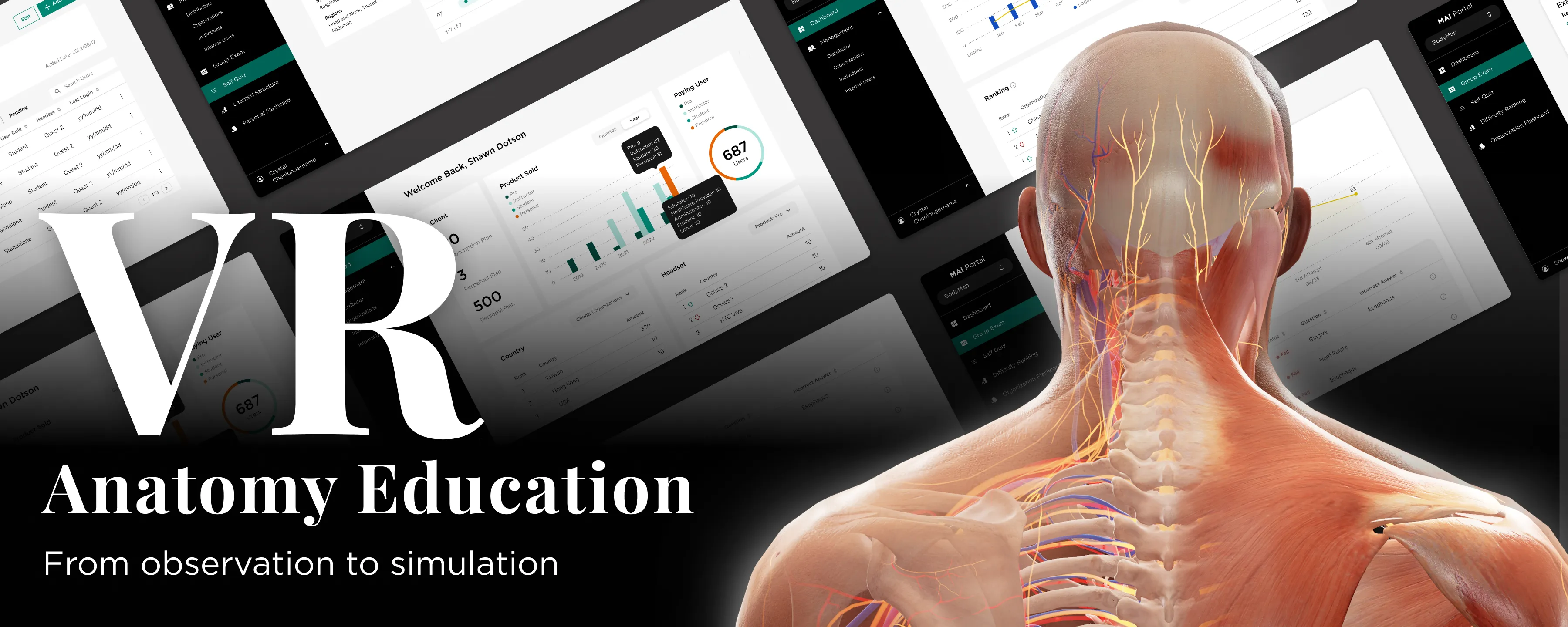Goal and Result
Improve VR & Web-based App by Research

This case study details how I collaborated with global teams to optimize our products through both quantitative and qualitative research. Over 15 months, we improved two VR apps, completed an unfinished dashboard, and uncovered new market opportunities—helping transform our VR education from a nice-to-have into a must-have for medical learning.
This case study is still under construction and will be released soon.
In the meantime, please visit my fully self-designed website for product introductions and rich learning content tailored for medical students:

Context and Challenges
Products:
BodyMap:
An immersive VR tool enabling exploration of over 5,000 anatomical structures from 12 body systems, reconstructed from MRI/CT data.
AcuMap:
A medically accurate VR acupuncture simulator showcasing 14 meridians and 361 acupoints.
Challenges Identified:
VR App Optimization Needed:
Existing features lacked polish; user feedback indicated confusion and inconsistency.
Research Fragmentation:
Initial insights were anecdotal, sourced from distributors and isolated user interviews.
Web App Incomplete:
No cohesive design system, limited user management, and no onboarding or trial flow.
Adoption Gap:
Institutions purchased our tech but struggled to integrate it into their curricula.
Task
We broke down the project into four progressive phases to fit the needs of our business and product services and to prepare for new opportunities.
Phase 01:
Finalize and launch the web portal, including user management and a trial experience.
Phase 02:
Consolidate research from partners (NTU, UCLA) and distributor feedback.
Phase 03:
Improve the VR experience, optimize tutorials, and align UI with classroom needs.
Phase 04:
Design and test a new dissection simulation mode with a course-based interface.
Each phase was aligned with technical feasibility and real-world classroom insights to ensure utility and adoption.
Action
Phase 01: Web Portal Development
Design System:
Built using MUI React, aligning UI components with engineering workflows.
Free Trial Flow:
Designed a seamless onboarding experience starting from either web or VR.
User Management:
Integrated subscription models and payment systems for educational institutions.
MAI Portal:
Launched the first dashboard version and completed internal documentation.
Phase 02: Research Consolidation
Key Partners:
NTU:
Used our app in formal classes.
UCLA:
Conducted product research and evaluation.
User Activity Data:
45% rarely used the system (<10 sessions/month).
35% used it occasionally (10–50 sessions/month).
20% used it actively (>50 sessions/month).
Behavioral Insights:
High skip rate on quizzes (60%).
66% preferred a custom view over system-provided ones.
Phase 03: VR UX Overhaul
User Needs:
Simplified onboarding process.
Reliable assessments replacing random quizzes.
Course alignment instead of a rigid 12-system layout.
Progress-tracking features to motivate students.
Solutions:
Redesigned tutorial UI in VR.
Integrated quiz logic with educational outcomes.
Developed a body-part tagging system aligned to course modules.
Implemented real-time progress tracking via the portal.
Phase 04: Dissection Simulation
Goals:
Create a course-based user interface.
Build MVP to collect market feedback.
Ensure instructors understand how to adopt simulations into their curriculum.
New Features:
Heart cross-section with synchronized ECG visualization.
Modular dissection sequences tailored for group learning (6 students per VR body).
Design Details
Under construction
Phase 04: Dissection Simulation
Goals:
Create a course-based user interface.
Build MVP to collect market feedback.
Ensure instructors understand how to adopt simulations into their curriculum.
New Features:
Heart cross-section with synchronized ECG visualization.
Modular dissection sequences tailored for group learning (6 students per VR body).




